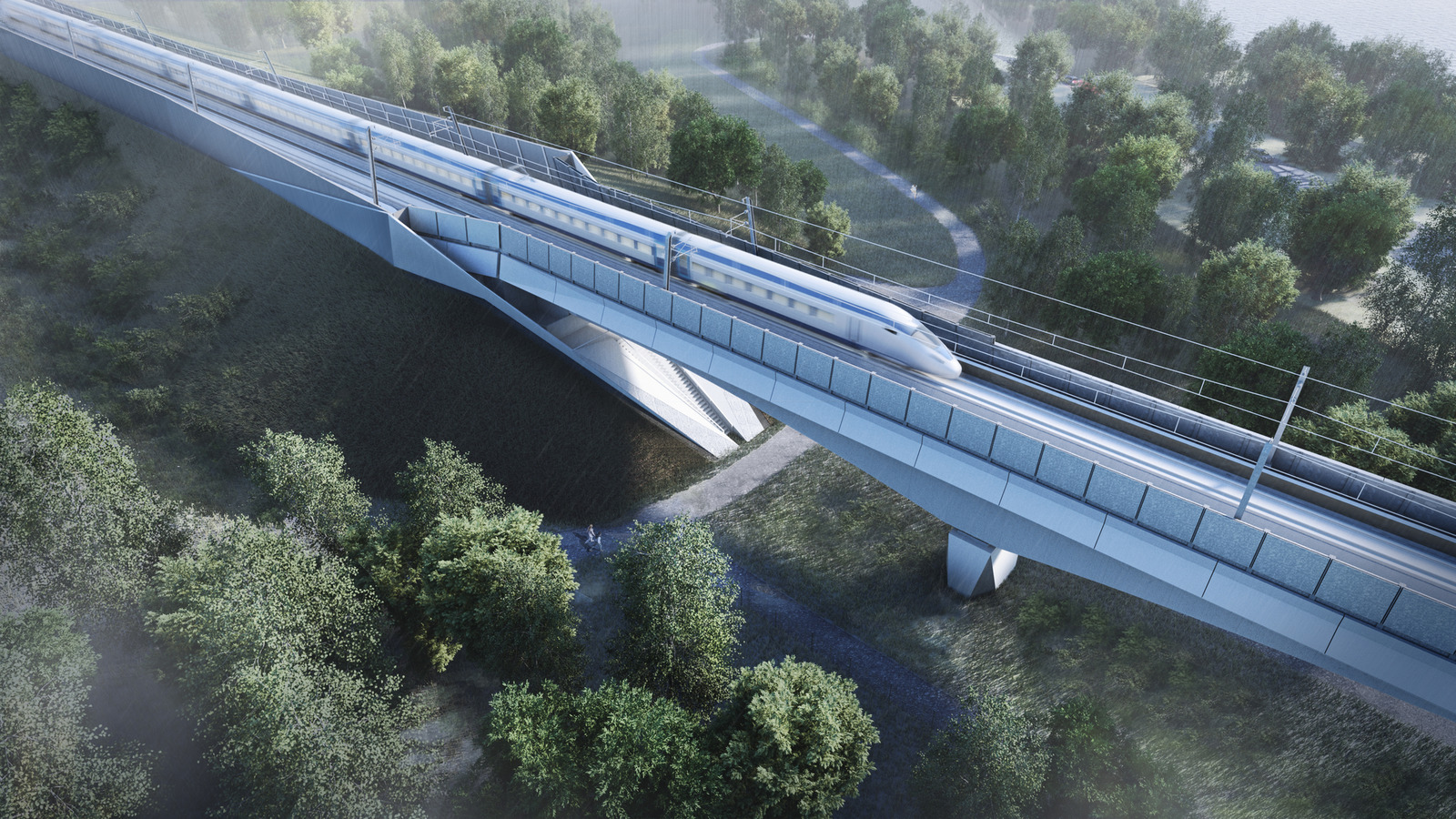
Railway systems
Railway systems in numbers
1,200 miles of optical fibre cabling will form the railway’s central nervous system
Rail Systems Alliance
We’re bringing the main rail systems contractors together under a collaborative Rail Systems Alliance structure. This will manage the connections between all parts of rail systems and resolve any conflicts in the programme.
The initial design stage of the work will run alongside the completion of civil engineering – which is now at its peak – so the rail systems contractors are ready to start work on site as soon as the civil engineering is complete.
Main rail systems contractors
Track Systems – Ferrovial Construction / BAM Nuttall JV
Ferrovial BAM will oversee the design and construction of the HS2 track infrastructure, manage construction logistics and support the testing and commissioning phase. They will act as Principal Contractor for works associated with the track and be responsible for logistics and consents coordination.
Track Urban contractor will deliver the installation of all track infrastructure on the section from Old Oak Common to the north portal of the Chiltern tunnel.
Track Central contractor will deliver the Central section from the north portal of the Chiltern tunnel to the south portal of the Long Itchington Wood tunnel, including the design and construction of the Infrastructure Maintenance Depot at Calvert.
Track North contractor will deliver the North section, from the south portal of Long Itchington Wood tunnel to the terminus at Birmingham Curzon Street, the interface with Washwood Heath Rolling Stock Maintenance Depot, and the permanent connection to the existing rail network at Handsacre Junction.
Switches and crossings and pre-cast slab track forming the HS2 track system will be delivered through existing contracts with Voestalpine and PORR UK – with the Track Systems contractor coordinating the design, logistics and installation. Rail will be supplied through Network Rail.
Overhead Catenary Systems – Colas Rail Limited
Colas Rail will be responsible for the design, manufacture, supply, installation, testing and commissioning of the Overhead Catenary Systems (OCS).
They will use the leading-edge V360 OCS design range under licence from SNCF Réseau to develop the next stages of design for HS2 Ltd. This system was the first in Europe to be certified for speeds of up to 360km/h and will provide power to the state-of-the-art high-speed trains.
The licence agreement allows the OCS contractor to go to the components market to find the most competitive supplier, opening up opportunities for smaller sub-contractors across the UK to be part of this cutting-edge project.
Tunnel and Lineside Mechanical and Electrical Systems – Costain Group plc
Costain will be a Principal Contractor, delivering the design, supply, manufacture, installation, testing, commissioning and maintenance (until handover) of the tunnel and lineside M&E systems.
The M&E systems include the tunnel services within the shafts, tunnels and cross-passages, and the low voltage electrical power distribution in the open route. The contractor will also design, supply, install, test and commission the tunnel ventilation systems.
High Voltage Power Supply Systems – Siemens Mobility Limited-Costain Ltd JV (SMC JV)
SMC JV will be responsible for the design as well as manufacture, supply, installation, testing, commissioning and maintenance of the high voltage (HV) power supply systems. A series of traction sub-stations will be built alongside the line to deliver power from the National Grid to the trains.
They will also deliver a dedicated HV non-traction power network that will provide power to stations, shafts, portals, depots and railway systems along the route.
Operational Telecommunications and Security Systems – Siemens Mobility Limited
Siemens will be responsible for the design, manufacture, supply, installation, safety authorisation, testing, commissioning and initial maintenance of the state-of-the-art operational telecommunication systems and the route-wide security systems. Spare capacity on the optical fibre network could also be sold to third party providers to help boost broadband access for more isolated rural communities.
Third party telecoms will sit outside the Rail Systems Alliance and will be responsible for the design, manufacture, supply, installation, safety authorisation, testing, commissioning and initial maintenance of the systems, which will provide the mobile communications for customers to use, as well as the emergency services and the station data network.
Command, Control, Signalling and Traffic Management – Siemens Mobility Limited
Instead of traditional coloured lights, HS2 will use a digital Command, Control & Signalling (CCS) and Traffic Management (TM) system that will support faster and more frequent services.
Siemens will be responsible for the design, manufacture, supply, installation, supervision, inspection, safety authorisation, testing, commissioning and maintenance of the CCS & TM systems until handover to trial operations, as well as ongoing technical support services of the CCS & TM systems.
Engineering Management System – Siemens Mobility Limited
The digital engineering management system will enable remote supervisory control of railway assets and systems by key operational and maintenance personnel, allowing the UK to run some of the world’s most reliable, safe and efficient high-speed rail services.
Siemens will be responsible for design, manufacture, supply, installation, integration, testing, commissioning and maintenance of an integrated Supervisory Control and Data Acquisition (SCADA) solution that will be used across the whole network – and up to 25 years of technical support.
This will enable the status of HS2’s operational railway assets and systems to be monitored and controlled in real time from the Network Integrated Control Centre in Birmingham and other key locations, facilitating both the safe operation and reliable maintenance of the railway.
A Reliable Railway
Our railway systems are part of what will make HS2 one of the world’s most reliable railways, with an engineering management system monitoring the network in real time to support day-to-day operations and maintenance.
We’re designing HS2 to withstand the impact of climate change and extreme weather by building in climate change adaptation and resilience at each stage of the project. We’ve assessed the impact of climate change on HS2 in our Environmental Impact Assessments. We’ve also considered how climate change, in combination with the impacts of the railway, may affect communities, businesses and the natural, historic and built environment along the route.
Withstanding extreme weather
Flooding risk and drainage systems
We reduce flood risk through drainage systems that prevent flooding and water building up on the tracks, without increasing the risk of flooding elsewhere. This includes:
- green tunnels with cut-and-cover designs and plants on top that act as a natural drainage system
- well-designed ditches, culverts and other drainage structures
- slabs to support our tracks that drain water quickly, prevent erosion and ensure stability, reducing the risk of line disruptions
All this means the HS2 rail line is designed to be resilient to a one in 1,000 year rain event.
Heat and cold resistance
Hot weather can cause overhead power lines to expand and sag, buckle the rails and even make the ground beneath the railway unstable. This can lead to the closure of lines or force trains to operate at slower speeds, causing disruption for passengers.
Our tracks are designed with rail expansion devices to accommodate thermal expansion and contraction to prevent them from buckling and causing delays during heatwaves. The rail expansion devices, along with specialised drainage systems, ensure people will be able to keep moving even when cold temperatures and snow hit the UK.
Points – moveable sections of the line that allow trains to switch between tracks – can freeze in cold weather, bringing the railway to a halt. All of HS2’s points will be fitted with a heating system that’s automatically activated when temperatures drop below a certain level. This makes sure they’ll keep working, even in icy weather, helping to maintain the punctual operation of the railway.
Ambient temperature
The design for Old Oak Common station features exposed surfaces that will absorb solar radiation entering through the roof-lights and other un-shaded areas to reduce the risk of indoor air temperature increases. We’ll also include shading devices to reduce the risk of overheating in both indoor and outdoor spaces. We’ve also completed a climate change adaptation and resilience strategy for all our stations as part of our work on BREEAM (a measure of sustainability for new and refurbished buildings).
Wind
Overhead power lines can be brought down in strong wind, which causes major disruption to services. To reduce this risk, HS2 will use an updated version of the overhead power lines developed for the Lyon to Marseille high-speed line.
To further enhance resilience, masts carrying overhead electric wires are placed closer together on sections exposed to stronger winds, for example on viaducts. Sharing the load of carrying the wires between more masts reduces the weight carried by each one, enhancing the line’s resilience against strong wind. Distances between masts on HS2 will range between 45 metres and 72 metres to ensure operational resilience.
Landslips
Landslips can cause major disruption, with earth spilling on to the tracks from above or crumbling away beneath a line, causing the railway to be closed. This often happens on the existing railway after long periods of heavy rain, when the ground becomes saturated. HS2 is being built with significantly shallower cuttings and embankment slopes than seen on the existing Victorian-built railway to significantly improve stability. Careful planting of vegetation, non-shrinkable soils (which avoid absorbing large quantities of water) and extensive built-in drainage will ensure stable ground around the railway.
Leaves
Thousands of tonnes of leaves fall on to railway lines in autumn each year from millions of lineside trees. They can be crushed by passing trains, creating a slippery layer on the rail similar to black ice on roads, making it harder for trains to accelerate or brake. HS2 will ensure that specific tree species will be avoided from day one to reduce the risks associated with leaf fall. Trees will also be planted well away from the line to avoid them being blown on to tracks during strong wind.
Email newsletters
Subscribe to our Project Update newsletter to receive the latest news and updates about HS2.
